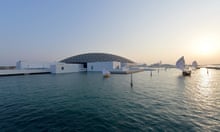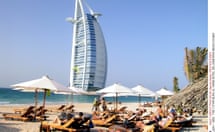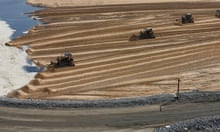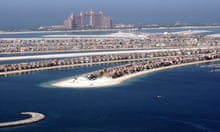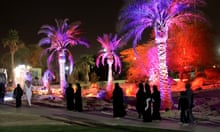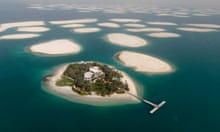I had the whole of Palestine to myself that day. It was only a short swim from Lebanon but, as I waded ashore out of the shallow, soupy water, it became clear that I was the only visitor the island had seen for some time. Clambering to the top of the hill, over a lunar landscape populated by the occasional piece of driftwood and the odd discarded beer bottle, I could see the sandy mounds of Jordan, Saudi Arabia and Ethiopia beyond, rising out of the sea like bobbing croutons. The gleaming spire of the Burj Khalifa twinkled through the haze on the distant horizon.
A decade since it was dredged from the seabed, The World is a forlorn sight. It was the most ambitious plan of Dubai’s pre-crash bubble, topping the creation of peninsulas shaped like palm trees and the construction of the tallest building on the planet, dreamed up as the ultimate trophy project to trump them all. In pursuit of the world’s attention, the oil-rich emirate would remake the world itself. “The Palm puts Dubai on the map,” proclaimed the marketing material at the time. “The World puts the map on Dubai.”
Conceived in 2003, the project was to be an exclusive offshore playground for film stars, royalty and celebrity tycoons: an artificial archipelago of 300 islands set two miles off the coast. Invitations to “Own the World” were sent to a targeted group of 50 potential buyers each year, offering tours of the site by yacht or helicopter, with prices for the islands ranging from $15-50m (£10-36m). Richard Branson posed for photos on little Britain in a Union Jack suit; Karl Lagerfeld launched plans for a fashion-themed island; rumours swirled that Brad Pitt and Angelina Jolie had acquired Ethiopia for their ever-expanding clan of adopted children.
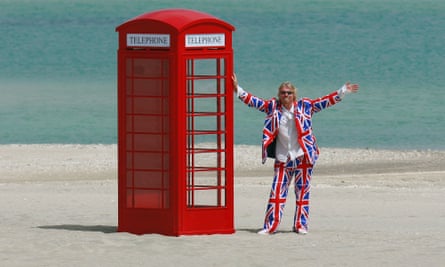
After five years of dredging, which saw 320 million cubic metres of sand and 25 million tonnes of rock hauled into place, the final stone in the breakwater was laid in January 2008 – on the eve of the global financial crisis. The vision collapsed just as quickly as the computer renderings had been conjured. Dubai World, the government investment arm in charge of the project, was revealed to have debts of $60bn.
Surveying the barren spots of sand that dot the sea today – which, in aerial images, make it look as if the Gulf is suffering from a nasty case of acne – it’s hard to shake the sense of an Ozymandian ruin. Covering more than 5,000 hectares – almost seven times the size of Venice – and encircled by a 20-mile-long breakwater, the remains of The World lie as a mind-boggling monument to the spectacular hubris of a moment in time when anything seemed possible. The owners of Ireland were planning to rebuild the Giant’s Causeway, along with typical Irish streets, pubs and rolling green countryside. A Chinese billionaire had drawn up plans to remake Shanghai’s skyline on his island, complete with a copy of the Oriental Pearl TV Tower. A company called Opulence Holdings had acquired Somalia, with ambitions to sculpt it into the shape of a seahorse, where residents could hit golf balls from their balconies.
Overnight, billions of pounds in construction contracts evaporated in a puff of sand, leaving a trail of bankruptcies, lawsuits and unpaid debts. The owner of Great Britain, Safi Qurashi, was jailed, accused of bouncing £50m of cheques (for which he was later exonerated, after serving three years), and the owner of Ireland, John O’Dolan, killed himself in early 2009. After years of being hounded by irate investors wondering where their money had gone, the British co-owner of Thailand, Imtiaz Khoda, was recently jailed for an unrelated fraud, as part of a group that conned NHS hospitals, councils and a government out of more than £12m. Dogged by associations with shell companies and criminal dealings, the whole project became toxic, damned by rumours of money-laundering, pyramid schemes and reports that the islands were sinking into the sea.

Lebanon was the only island that opened to the public, and it still struggles on today. For 200 dirham (£40), you can spend the day at its world-weary beach club, paddling in the pool and eating wagyu beef sliders on a faded fibreglass sun lounger. The island plays host to champagne-fuelled jamborees by night, as a venue for fashion shows, DJ parties and debauched corporate events. It seems like an appropriate place for a bit of end-of-the-world hedonism, surrounded by a scene of post-apocalyptic desolation.
So it comes as some surprise to learn that construction is back under way. Standing on Lebanon’s beach alongside a small handful of other bewildered tourists, I see diggers in the distance, shifting sand beneath what looks like the frame of a substantial new building on an island next door. Trucks are trundling from a concrete batching plant on Monaco over towards Sweden, where a series of villas are under construction, designed in collaboration with Bentley Home. On Italy, the Portofino Hotel is rising out of the sand, billed as the first family-oriented five-star hotel in the region. The ground is being prepared for the arrival of a sprawling Alpine-themed complex on the island of Switzerland, while a speedboat brings a couple of Emirati buyers to view a floating show home, and to marvel at the view from its glazed underwater bedroom. After a decade in limbo, The World is back – with more ambitious plans than ever before.

“I am going to make it snow all year round,” says Josef Kleindienst. He is sitting in a white leather armchair in his office at the top of a tower in Dubai, from where he can survey the fronds of the Palm Jumeirah stretching out into the sea below. In the room next door stands an enormous model of his vision for the Heart of Europe, a fantastical concoction of Austrian castles, Swiss chalets and Russian palaces (and, oddly, Polynesian huts) set across a group of six islands, connected by meandering walkways and baroque bridges. “Rain and snow might not be so attractive if you live in northern Europe, but to someone in Dubai they are magical things,” he says. “People here dance in the street when it rains.”
With his heavy Austrian accent, imposing stature and chilly demeanour, Kleindienst has the air of a Bond villain, and I half expect him to unveil a giant laser cannon for making it snow on his desert islands. He explains how he has been working with scientists at the Fraunhofer Society in Germany to develop outdoor cooling technology using cold water. It has the same energy consumption and uses the same principle as conventional air conditioning, he says, except that the water will fall from a network of pipes in the form of rain. On a plaza in the Swiss-themed resort, the temperature will be cranked down a few notches to make snowflakes, which he says will settle on the ground thanks to cooling pipes buried beneath the surface.
As a former police chief inspector, who set up his property development business in 1998 and moved to Dubai in 2002, Kleindienst makes an unlikely saviour of The World. He bought the island of Austria in 2006, before catching the bug and acquiring three more islands, then another three. Owners received access to their patches of sand from the master developer, Nakheel, in September 2008, one month before the full force of the financial crisis hit Dubai. “There was a chance, and there was a risk,” he says. “All the others saw the risk and left. We saw the chance and stayed.”

As we walk around the big model, Kleindienst ticks off his countries and attractions, like God inspecting his handiwork on the seventh day. “St Petersburg is our honeymoon island,” he says, pointing out a blob of land that they have remodelled in the shape of a heart, dotted with thatched cabins, from which long piers extend to provide mooring posts for “Floating Seahorse” villas, on sale for 12-15m dirham (£2.3m–£2.9m). “Then we have the main Europe island, with our Ibiza party hotel and four city hotels – Munich, London, Amsterdam and Scandinavia, connected by a circular, glass-bottomed swimming pool on the roof – and the Ikaria wellness hotel, named after the Greek island where people live longer and healthier than anywhere else in the world.” It is a heady global smorgasbord, with little concern for geographical accuracy or architectural vernacular.
Germany has been reserved for higher-end occupants – “the second or third homes of your average millionaire” – while Sweden is billed as the pinnacle of exclusivity, featuring 10 “palaces”, whose rooftops are modelled on the upturned hull of a viking ship. They come complete with infinity pools, private beaches and furniture branded with the winged B of Bentley. Kleindienst claims they have all been sold to members of the Gulf states’ ruling families, the last one for 75m dirham (about £15m).
Just as Dubai’s ruler, Sheikh Mohammed, gifted one of The World islands to Formula One champion Michael Schumacher in 2006, as a ruse to encourage others to come here, so Kleindienst hopes to use the presence of royals as bait. “We know that where the royals are spending their summer vacation, many other people also want to be,” he says. But would privacy-seeking princes really want to relax anywhere near hundreds of other people holidaying in an Ibiza-themed resort? “One of our buyers could easily afford to buy a whole island of his own,” says Kleindienst, “but he wants to be part of our project so he can experience the snow plaza and enjoy all of the entertainment we will be laying on. We will have a restaurant from every country in Europe, and a different cultural festival each night.”
With distances of just a few metres between the islands, it doesn’t feel like a particularly exclusive place. You’ll be able to wave at your neighbouring billionaire across a shallow channel. “We are working on floating landscaping for privacy,” says Kleindienst. “We have already tested floating palm trees.”

Trees won’t be the only things bobbing in the water. Given the high premium on land, his firm is developing plans for entire floating islands, beginning with Venice. Gondolas will weave between modern palazzos, set around a swimming pool proportioned to match St Mark’s Square, while underwater bedrooms and restaurants will provide views on to a new coral reef. He says they have already established a coral nursery on one of the islands, and plan to cultivate oyster beds too, with pearl-diving added to the list of attractions on offer.
Wading through the murky water today, it is hard to believe the Photoshopped visions of people frolicking among shoals of exotic fish in a crystal-clear lagoon, lounging in their underwater lairs or playing in the snow. Kleindienst says the entire development and its 4,000 bedrooms will be completed in time for the Dubai Expo in 2020, which seems impossibly tight. He insists that most of the Floating Seahorse villas have been sold, promising investors a guaranteed yield of 8% over five years; but these figures are hard to take seriously when current prime residential property yields in Dubai stand at around 5%. Nor might it be of particular encouragement to investors that one of Kleindienst’s structures recently sank following a New Year’s Eve party.
For all the hype, industry insiders raise their eyebrows at the idea that The World is back on track. “When you go into these marketing suites, it feels like 2007 all over again,” says Dubai-based architect Sara Anwar, who was involved with Karl Lagerfeld’s plans for a fashion island, Isla Moda, before the financial crisis hit. The project, developed by Dubai Infinity Holdings, was to include a fashion resort, themed residential villas, haute couture boutiques and luxury hospitality facilities, all aimed at ultra-high net worth individuals (or UHNWIs as they are known – an acronym that, when pronounced, sounds appropriately like “unwise”).

“Every five minutes a bus would arrive at the sales office full of potential buyers, and people would fly here on their private jets for the most lavish launch parties imaginable,” Anwar says. “Everyone here on the ground had a real belief in what was happening, but there was definitely a sense of skepticism from outsiders when they arrived.”
Others dismiss the new plans outright as a financial loser, but Kleindienst’s bullish attitude appears to be rubbing off. After a decade of despair, some other island owners have been buoyed by the company’s efforts. Emirati developer Seven Tides announced in September that it plans to complete a 100-villa resort on one of its 10 islands in the South America cluster by the end of 2018.
“This will be the first resort of its kind anywhere on The World,” said the company’s CEO, Abdulla Bin Sulayem. “The design is beautiful, which is important, because if we don’t have a ‘wow’ factor, there’s no point in doing it.” Commenting on the unlikely speed of the project, he added: “When you’re building lots of [similar structures], everything is like Lego,” which doesn’t bode particularly well for the quality of the plans. It’s not the first time Seven Tides has announced its intentions to be the first to have a resort open on The World. In 2009, it promised a scheme of chalets on stilts would be “opening soon” on the islands of Buenos Aires, Bolivia, Argentina, Chile and the Falklands, complete with swimming pools and tennis courts. Nothing has materialised.
As if to complete the sense of deja-vu, bringing back a touch of celebrity sparkle, Mean Girls star Lindsay Lohan, who recently relocated to Dubai, has announced that she too is designing her own island on The World. “I have a lot of little projects [in Dubai] because I like to keep busy,” she told a US talkshow in January, describing her expansive range of branded enterprises, from a new makeup line to nightclubs in Athens and Mykonos, and now “Lohan Island”. “I’m out Trump-ing Trump with the name Lohan!”

These days there is no sign of The World in the sales office of Nakheel, the government-owned development company that was founded in 2000 to head up the offshore projects. Crossing a bridge over an azure pond, I arrive at their complex of domed buildings set a in lush tropical garden, to be welcomed into a marketing suite beneath a soaring marquee roof recalling a bedouin tent, where polished steel palm trees tower over a model of the Palm Jumeirah.
“People ask why we build new land in the sea when we have so much empty desert,” says Mohammed Rashed Bin Dhabeah, Nakheel’s managing director of development, adjusting his crisp white keffiyeh. A vitrine of miniature sports cars stands against one wall of his office, and a signed Lionel Messi football shirt hangs framed on another. “We only have 60km of beach running along the coast of the Emirates, but we have 14 million visitors a year who come here for the beaches. So we needed to create more beach.”
It all began with the Palm Jumeirah, an idea credited to Sheikh Mohammed, who is said to have sketched out the form of the trunk and fronds as the most efficient shape to maximise the amount of beachfront. Each frond would be like a street, with a row of properties on either side, backing on to their own stretch of private beach. The novelty shape and the promise of beachfront homes was a winning formula: the plots sold out in two days.

Walking up the hard shoulder of the roaring highway of the Palm today (there is no pavement; everyone drives), the feeling is less one of an exclusive private enclave than that of a generic slice of American suburbia. The houses have been packed in cheek by jowl, at three times the original planned density, leaving rows of McMansions looking across at each other between thin strips of stagnant water.
In the sales brochures and news reports, this new form of Google Earth urbanism was intoxicating, especially given that much of the intended audience would never see it in reality. The media frenzy generated by the Palm was enough to convince Nakheel to plan a further two palm-shaped islands of even greater size: the Palm Jebel Ali, further south along the coast towards Abu Dhabi, and the gargantuan Palm Deira nearer Dubai’s old town centre, seven and a half times the size of the original. Together, they would add more than 250 miles of coastline to the shores of Dubai, and provide an additional 6,000 hectares of land – an area larger than the whole of Manhattan. In a move that now seems like tempting fate, the Palm Jebel Ali was to feature a halo of calligraphically shaped islands, spelling out the lines of a poem written by Sheikh Mohammed: “Take wisdom only from the wise, / Not everyone who rides a horse is a jockey. / It takes a man of vision to write on water, / Great men rise to great challenges.”
In this case, the challenge proved too great. The shape of Jebel Ali was formed, but the project has been on hold ever since. Meanwhile, Palm Deira got as far as the base of the trunk before the rest of the tree was cancelled, its sorry stump since rebranded “Deira Islands”.
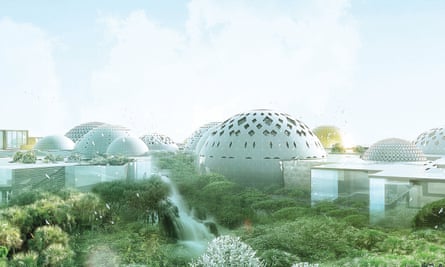
Caught up in a frenzy of shape-making, before the palms hit the buffers, The World was the obvious next step. “After the success of the Palm Jumeirah, people wanted their own private islands,” says Bin Dhabeah. “The World was a way of creating a place where each person could do their own thing.”
On the corridor outside his office hangs a satellite view that shows not only The World and the three palms, but a cacophony of other swirly shapes that fill the entire area of sea between the mainland and the existing islands. There are moon-shaped crescents, cosmic starbursts and wiggling worms, arranged in an indiscriminate muddle, as if someone had spilt a bowl of spaghetti shapes across the map. This is The Universe, an aborted plan for an additional 3,000 hectares of fantasy islands shaped like the Milky Way and the solar system. It was announced in January 2008, just as The World was completed, but was swiftly sucked into the great black hole of the financial crisis, never to be seen again. “We don’t talk about that one,” says the PR, chivvying me out of the office.
Sitting at home in Miami, the architect of these crazed visions recalls a time when Nakheel couldn’t have been keener to shout its plans from the rooftops, recounting a rose-tinted era when nothing was deemed too outlandish.
“They were totally unfazed by anything,” says Luis Ajamil, president of architecture giant Bermello Ajamil & Partners, a practice whose CV boasts the momentous accomplishment of masterplanning The World and The Universe. “The Universe would have been longer than Miami Beach in its entirety. It even had its own airport, and would have needed 1 or 2 million people to make it successful. They said: ‘So what?’ If you said no to them, it was their trip to say: ‘OK then, we’ll do it.’”
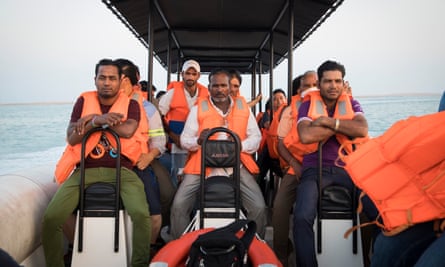
Ajamil did manage to bring a little bit of market sense to the madness. Before he got involved, The World had been planned solely with private owners in mind. “It soon turned out that there weren’t 300 people who wanted to buy an island for $30m,” he says, “so we changed the plan and increased the density to make it commercially viable, more like a city without cars. Imagine Venice on steroids.”
His team developed a zoning plan, locating the more public, resort-style islands closer to the mainland, while the more exclusive areas for private estates were sited further back towards the Gulf. Antarctica was imagined as a big commercial hub, with rows of seven-storey hotels and a mile-long beach facing Dubai, creating a wall of development that would have essentially blocked the sought-after view of the mainland from the private islands behind.
Ajamil says sales really took off when they demonstrated how owners could re-shape their islands, carving coves, inlets and marinas to create more saleable area. “We went from trying to sell a bunch of pancakes to showing people how they could make spaces that could really work commercially. The smart folks figured out that the game was to work with the water, given that the plots of land were so small. You could put buildings on stilts and bring boat slips in underneath them. It was a lot of fun. We did some kick-ass projects.”
His practice worked on a number of the early schemes, including a plan to divide Moscow into two linear islands, connected by a five-storey glass box called Red Square, which would have glowed red by night. He also planned to slice the UK landmass in two, connecting the slivers with what he describes as “an abstract interpretation of Tower Bridge”. That wasn’t the only replica icon: “A lot of people were looking at recreating wonders of the world. At one point I counted seven Eiffel Towers.”
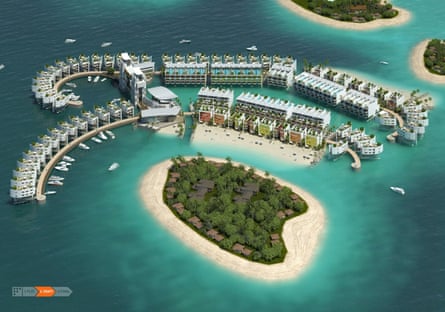
The whole premise behind The World was fundamentally transformed from being a community of exclusive desert islands, with a villa on each, to thin strips of sand carved, stretched and squeezed to ensure the maximum commercial return. Bermello Ajamil’s design for the UK bears no relation to the outline of Britain, or to its architecture. Instead, it looks like a pair of mating caterpillars, the two spits of land whittled away into long, curling tendrils, upon which dozens of white modernist holiday homes have been packed side by side. The high-density rezoning paved the way for Kleindienst’s plans, which do their best to fill every square inch of land and sea available, creating an atmosphere redolent of the Costa del Sol.
The Universe would have only increased the congestion – it was planned at a higher density still. But all of this planned terraforming was facing a more fundamental hurdle: they were running out of sand. “When they started building the first Palm, the dredgers just went out and scoured sand from a few hundred metres around the site and piled it up,” says Ajamil. “But as they built the next palm and The World, there was no sand left nearby. By the time The World was being finished, the ships were going out 20km or more. The costs were getting prohibitive.”
And presumably the tangled knots of the Universe would have drastically reduced the value of the existing islands? “Absolutely,” says Ajamil. “But, by then, a lot of The World was already sold.”
The speed of the sales, at the height of the bubble, was based on the fact that buyers would readily pay 100% cash up front, based on drawings alone. “You didn’t need to raise capital – that’s why things moved so fast,” he says. “Now it’s a model that requires risk and debt, and a lot of these developers are not equipped for that.” Still, he is optimistic that The World will be inhabited one day.
“It will take a different mindset and a bit of focus from the Dubai government, but it’ll happen. There are billions of dollars of sales that have been made. That money is not just going to sit out there for ever.” Unless, that is, those billions have already been swallowed into the sea.
Follow Guardian Cities on Twitter, Facebook and Instagram to join the discussion, and explore our archive here



